ADDRESS TO FACULTY SENATE AND UNIVERSITY COMMUNITY
PRESIDENT JOEL SELIGMAN
SEPTEMBER 7, 2010
I INTRODUCTION
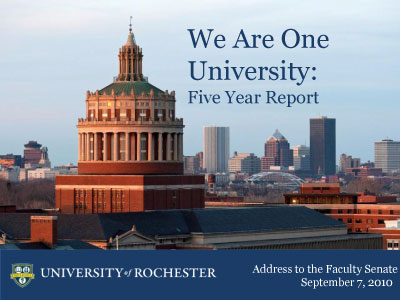
By many measures, last year was among the most impressive in our University’s 160 year history.
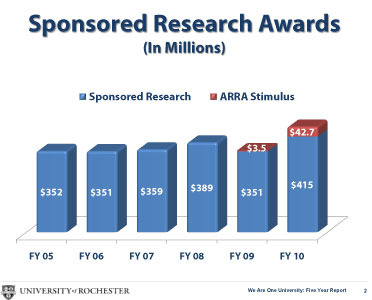
This was strikingly evident in sponsored research. In the 2010 federal fiscal year, the University received government and private research funding equal to $415 million, some $64 million more than the previous year, with an additional $42.7 million received from the American Recovery and Reinvestment Act.
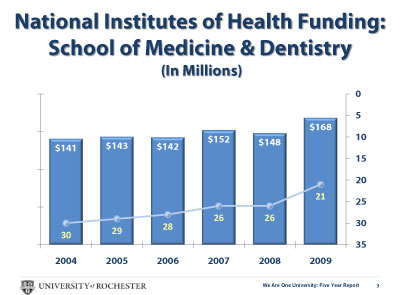
There is a clear momentum with respect to research at the University. Last year, the School of Medicine and Dentistry, for example, ranked 21st in competitively awarded National Institutes of Health (NIH) grants compared to 30th in NIH awards five years ago, including programs in orthopedics, obstetrics/gynecology, neurosurgery, neurology and emergency medicine, which were ranked in the top seven in the country. Last year the School of Nursing similarly was ranked 7th in NIH grants.
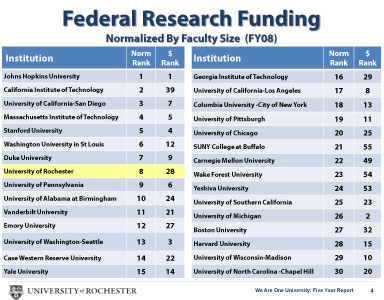
To make this point in different terms, for fiscal year 2008, the most recent year for which data are available, we ranked 28th in federal research expenditures received by comprehensive research universities. When this indicator is normalized for tenured and tenure track faculty, we ranked 8th in the nation. Pound for pound, we can be proud to be among the nation’s leading research universities.
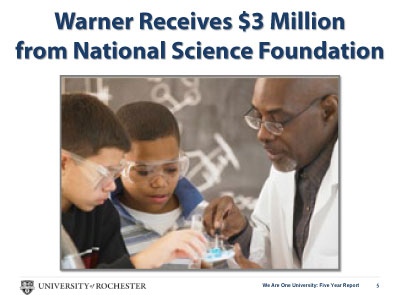
Nor is our vitality in sponsored research limited to medicine, engineering and the life sciences. Recently, the Warner School of Education was awarded $3 million from the National Science Foundation to collaborate with the Rochester City School District on means to strengthen K-12 math and science.
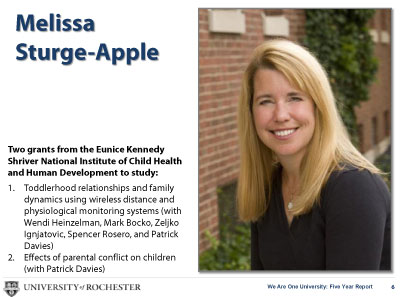
Psychology Professor Melissa Sturge-Apple and a multidisciplinary team last year were awarded $6 million in two separate grants to study toddlerhood relationships and family dynamics and, second, the influence that interparental violence has on parenting methods and how it affects a child’s adjustment.
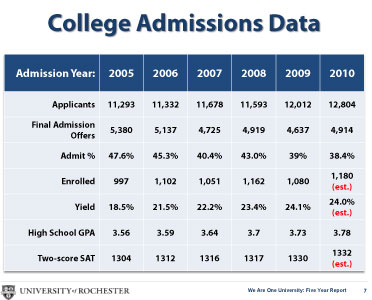
A different measure of University progress involves undergraduate applications to the College, which last year broke another record, totaling 12,804 for the Class of 2014, while achieving ever higher levels of entering student achievement.
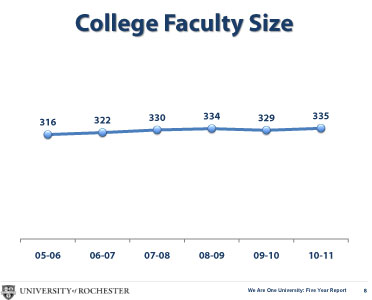
The College also had one of its most successful hiring years in its history, adding 18 tenured or tenure track professors, including two to arrive next academic year, and increasing the overall size of Arts, Sciences and Engineering faculty this year by six.
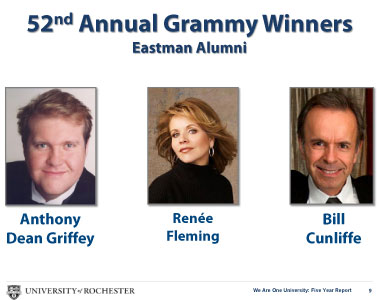
Eastman School of Music faculty and alumni received 10 Grammy nominations last year, and three alumni won Grammies: Anthony Dean Griffey for Best Classical Album and Best Choral Performance; Renée Fleming for Best Classical Vocal Performance; and Bill Cunliffe for Best Instrumental Arrangement.
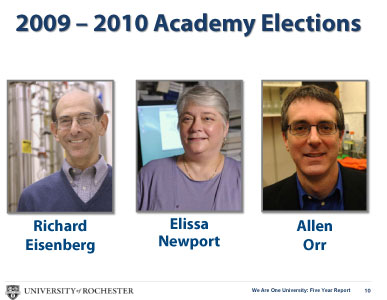
Underlying the University’s overall success is the excellence of our faculty. Faculty quality is the greatest resource of the University of Rochester. Your teaching, your mentoring our students, your research, your scholarship are what make the University of Rochester the extraordinary institution that it is. With all my heart, I thank you for your hard work, your dedication, your wonderful spirit.
Last year was a particularly memorable one for three professors. Let me today recognize Richard Eisenberg, the Tracy H. Harris Professor of Chemistry, who was elected both to the National Academy of Sciences and the American Academy of Arts and Sciences; Elissa Newport, the George Eastman Professor in Brain and Cognitive Sciences, previously elected to the National Academy of Sciences and American Academy of Arts and Sciences, this year was elected to the American Philosophical Society; and Allen Orr, University Professor and Shirley Cox Kearns Professor, who this past year was elected to the American Academy of Arts and Sciences.
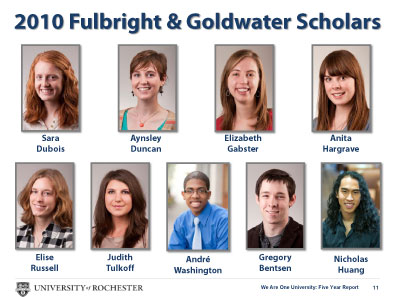
The achievements of many of our students also were stellar. Seven University of Rochester students last year won Fulbright Student Program Scholarships and two students were named 2010 Goldwater Scholars.
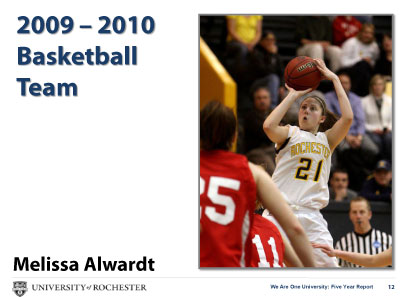
Both our women’s basketball team and
our squash team finished the year among the top four teams in the nation.
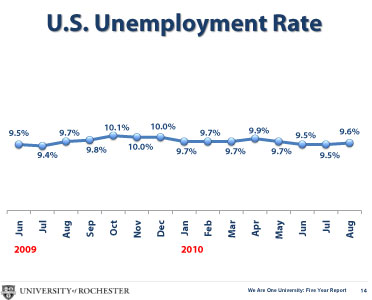
Simultaneously with an impressive year for our University, however, the nation’s economy continues to suffer its longest and most painful post-World War II recession. Unemployment, as of the last report, was officially 9.6 percent, little changed during the past year, despite a nearly $800 billion stimulus package in February 2009.
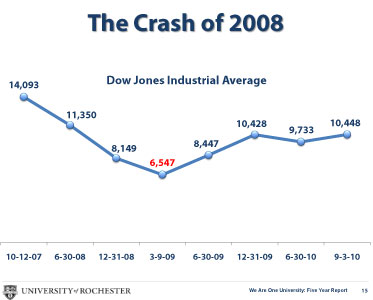
While debt markets have reopened and the stock market has rebounded significantly from its March 2009 low point, we remain in a period of global economic recession.
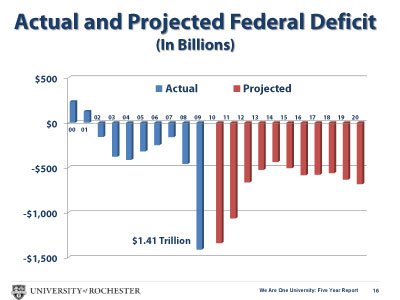
For the University, the greatest consequence of our ongoing recession involves the very high levels of current and projected federal and state deficits. For the next several years, a major aspect of national and state policy inevitably will focus on deficit reduction.
All divisions of the University have economized during this challenging period. For fiscal year 2010, for example, Strong Memorial and Highland Hospital have sustained revenue reductions in the federal Medicare and State Medicaid programs totaling $23.1 million. Separately, the School of Medicine and Dentistry has set a goal of reducing the School’s budget over time by $30 million. The College of Arts, Sciences and Engineering last year decreased its endowment payout by approximately $10 million. Virtually everyone in the University has experienced periods of salary freeze or worked to reduce expenses. For this all of you deserve the greatest possible gratitude.
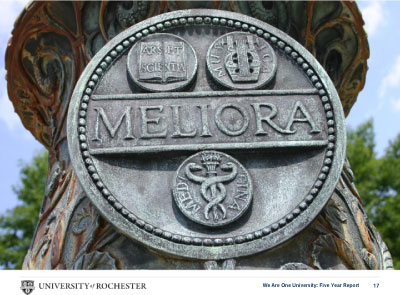
Against this background, let me frame the state of the University, emphasizing three overarching themes:
First, the University of Rochester as an ongoing institution is both stable and strong. While we will be challenged by the same economic forces that affect the entire world, our core academic and clinical care operations will continue to demonstrate the agility to effectively meet whatever challenges are sent our way.
Second, the magnitude of what we can achieve in our strategic plans over the next few years has been reduced. We have begun what will be the most significant comprehensive capital campaign in our history – but it will be based on a more limited realization of our objectives. We will achieve much, but not all, of what we sought when our strategic plans were approved by our Board of Trustees in October 2008.
Third, this nonetheless is our time for transformational progress at the University of Rochester. We today have the opportunity to significantly strengthen the University of Rochester because: (1) our schools generally are less reliant on endowment payout than many, if not most, of our better endowed peers; (2) public universities generally are facing sustained and sometimes brutal state budget cuts, which means, among other things, that faculty of unusually high caliber are more interested in relocating here; and (3) we are far along in our planning toward a comprehensive capital campaign whose magnitude can make a significant difference to each of our academic programs even in the context of modified strategic goals. Preparing for the October 2011 public launch of our comprehensive capital campaign and working for its success will be my top priority during the next five years.
I am optimistic about our future. My optimism is based on a sense of how far we have come in the last five years and how much I believe we will achieve between now and June 30, 2016, when our first comprehensive University wide capital campaign is completed.
Let me today take a long view and give you a five-year report of the progress we have made and articulate what I believe we will achieve in the years to come.
II A FIVE-YEAR REPORT
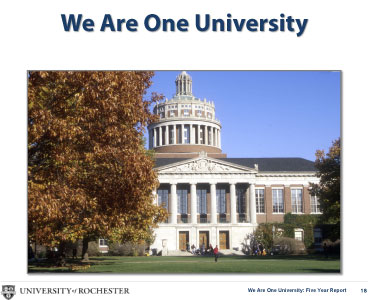
Five years ago, I emphasized in my inaugural address that “We are one university,” bound together by a commitment to four fundamental values: academic excellence, academic freedom, diversity, and community.
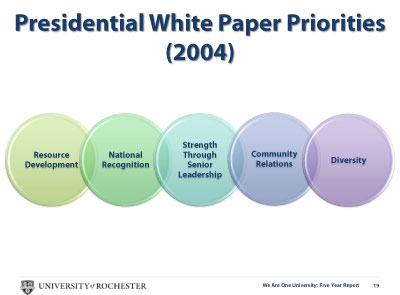
I stressed in my first remarks to this Faculty Senate in 2005 that our challenge would be to address the most visible tasks identified in the Presidential White Paper developed by the Board and faculty search committees before I arrived: resource development; national recognition; sustaining strength through senior leadership; promoting strength in Greater Rochester; and diversity. The key to acting consistently with our fundamental values and to achieving our overarching objectives is strategic planning.
The past five years provide compelling evidence that this is a University unequivocally moving in the right direction and one that will continue to make substantial progress in strengthening the University of Rochester and the greater Rochester community.
A. RESOURCES
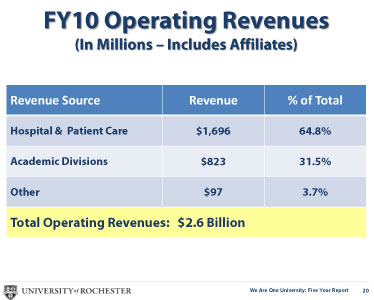
The University’s operating revenues in FY 10 were $2.6 billion, of which $1.7 billion (or 64.8 percent) was generated by hospital and other clinical care.
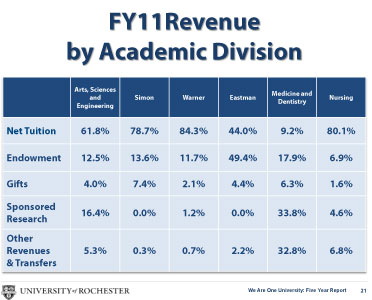
Our six academic divisions generate income from five principal sources: (1) Net tuition; (2) sponsored research; (3) endowment; (4) gifts; and (5) other revenues and transfers.
FY11 Revenue by Academic Division
| College | Simon | Warner | Eastman | SMD | SON | Net Tuition | 61.8% | 78.7% | 84.3% | 44.0% | 9.2% | 80.1% | Endowment | 12.5% | 13.6% | 11.7% | 49.4% | 17.9% | 6.9% | Gifts | 4.0% | 7.4% | 2.1% | 4.4% | 6.3% | 1.6% | Sponsored Research | 16.4% | 0.0% | 1.2% | 0.0% | 33.8% | 4.6% | Other Revenues & Transfers | 5.3% | 0.3% | 0.7% | 2.2% | 32.8% | 6.8% |
The two most promising areas for potential growth in the next five years are likely to be endowment and gifts.
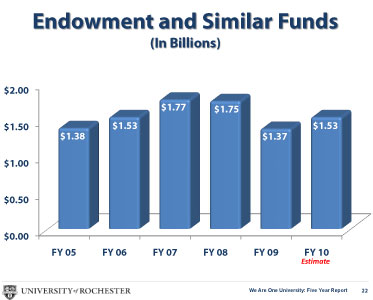
When I began on July 1, 2005, the University endowment was $1.38 billion; the average contributions to the endowment during the previous five years were $13.9 million per year and annual cash contributions for all fund raising had averaged $62.5 million per year. We had in place an underdeveloped advancement process which was smaller, more decentralized, and whose results lagged behind our peers in virtually all relevant measures.
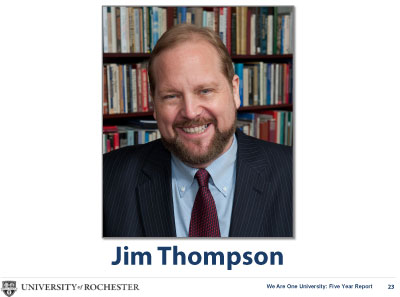
During the past five years, we have taken significant steps to transform the Advancement program, including hiring Jim Thompson to lead Advancement and adopting a new financing mechanism for central advancement.

Working with the Board of Trustees Development Committee, we have implemented a Business Plan which has led to significant results, such as the tripling of Board annual giving support between the 2005 and 2006 academic years; growth between FY 06 and FY 08 of annual total cash contributions from $69.9 to $109.1 million (before declining to $75 million in FY 10 during the current recession); significant growth in future pledged funds (from $8.9 million in FY 06 to $127.7 million in FY10); a doubling of the annual fund from $5.1 million to $10.5 million in five years, making ours one of the fastest growing annual funds in the country; a total of $534.7 million in cumulative total cash and future pledges as of June 30, 2010; the identification of 10,752 significant potential supporters of our University through the University Leadership Initiative and other means; and the creation of the
George Eastman Circle that provides continuity in annual giving and which as of August 2010 had grown to 1,427 members. During the five years 2006-2010, new contributions to the endowment increased to an average of $19 million per year.
We are building a system of alumni relations and advancement that will last far into the future. A significant success has been the establishment of the George Eastman Circle, which we anticipate will grow from its current membership over 1,400 to as many as 2,000 members by December 2011. Their support will strengthen our University for decades to come.
B. COMMUNICATIONS
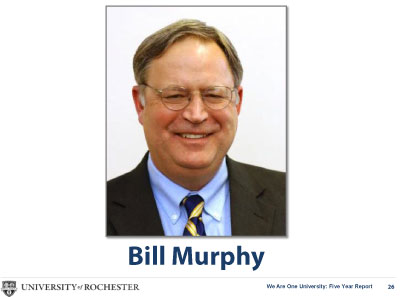
In the past five years, we have transformed Communications from a relatively low-keyed effort (with some notable successes such as Rochester Review) to a far more effective mechanism to communicate the University’s identity, quality, and its contributions to society. Pivotal to this progress has been the leadership of Bill Murphy, who began here in 2006.
Under Bill’s leadership, the Communications program:
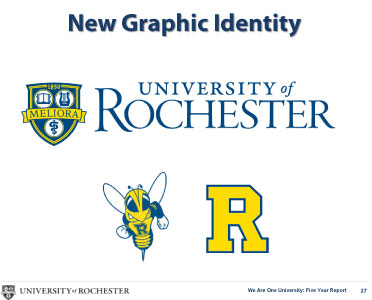
-
- Launched a new graphic identity, including logo, spirit R, and Yellowjacket mascot (Rocky) to increase the visual consistency and reinforcement of the University’s communications.
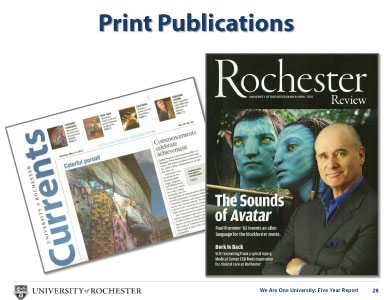
Redesigned Rochester Review and expanded it to six issues, expanded Currents from four pages to eight and increasingly publishing alumni publications such as Rochester Medicine and Rochester Nursing on-line.
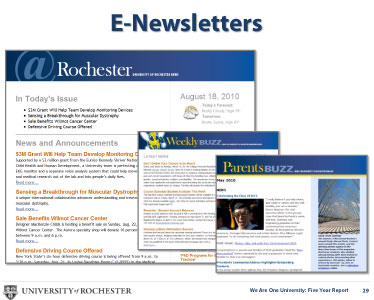
Reconceived @Rochester as an e-newsletter for 17,000 faculty and staff and created e-newsletters for undergraduates (Weekly Buzz), graduate students (Grads@Rochester), parents of undergraduates (Parents Buzz), and alumni (Rochester Buzz).
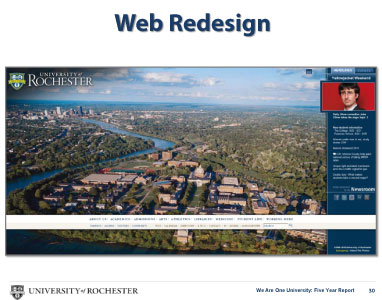
Created a new design for the University’s home page and top Web pages, recognized by the Bivings Report in 2010 as one of the 11 best Web sites in the nation.
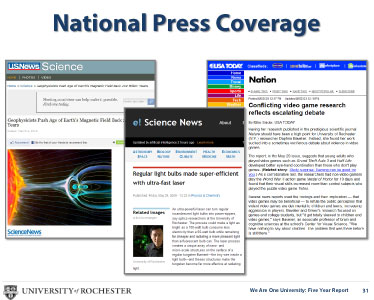
Expanded the media relations staff, resulting in a significant increase in media coverage, for such stories as Brain and Cognitive Sciences Professor Daphne Bavelier’s work on violent video games; Institute of Optics Professor Chunlei Guo’s work on laser-etched silicon; Susan Hyman’s research demonstrating that strict diets do not ease the symptoms of autism; Karl Kiebutz’s study of a new drug that potentially may treat Huntington’s disease; Political Science Professor Randall Stone’s analysis of the International Monetary Fund and the debt crisis; or Earth and Environmental Science Professor John Tarduno’s studies on the Earth’s magnetic field.
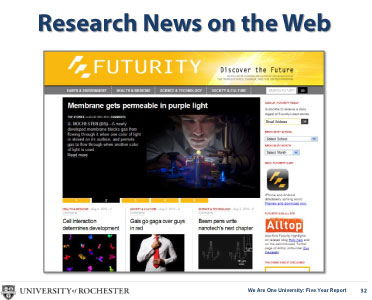
Communications also took the lead, with Duke and Stanford, in creating Futurity.org, an online research magazine representing a consortium of 59 research universities in the United States, Canada, and the United Kingdom. Since its launch, Futurity has been visited over one million times.
Communications now has in place an effective system to address current internal and external media. Our primary challenges during the next five years will be to respond to the digital revolution which is transforming the world of communications while working to be even more effective in articulating the University’s identity and achievements. These challenges include:
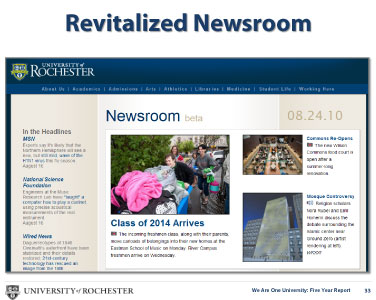
-
- Adapting our press releases to better serve the general reader, not just journalists, as well as adding more video and animation to increase stories’ appeal.
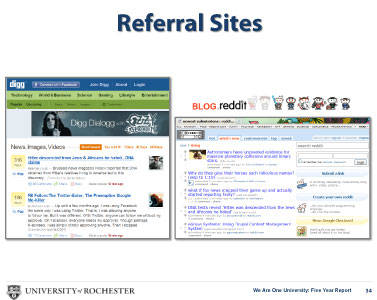
Learning to work more effectively with referral sites such as Digg and Reddit to multiply the reach of our communications.
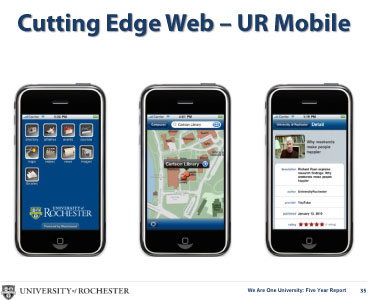
Experimenting with new ways to keep the University Web site on the cutting edge of 21st century communications.
C. COMMUNITY RELATIONS
I have worked with senior leadership on a five-pronged approach to strengthening the University’s role in the Greater Rochester community.
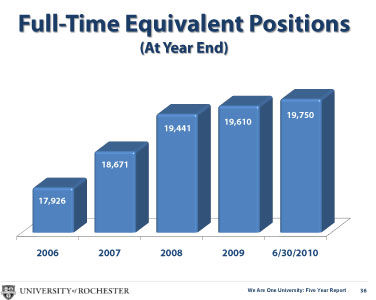
First, we continue to strengthen the Rochester economy through job growth when this is consistent with University strategic objectives. As of June 30, 2010, we employed 19,750 Full Time Equivalents and employed more than twice the number of individuals of the second largest employer in our region.
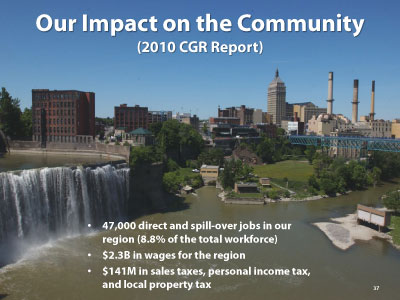
The University is now the sixth largest private employer in New York State. When our direct employment is combined with affiliates, the University in 2009 was responsible for approximately 47,000 direct and spill-over jobs in our region or approximately 8.8 percent of the region’s total workforce. The University added $2.3 billion in wages to the region in 2009 and generated $141 million per year in sales, personal income, and local property taxes to the Rochester region and New York State, according to the Center for Government Research.
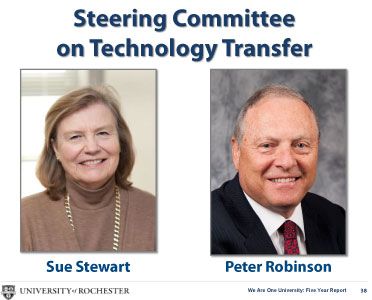
We have particularly focused on research and innovation. In November 2006, the Steering Committee on Technology Transfer and Corporate Alliances, co-chaired by Peter Robinson, Executive Director of Government and Community Relations, and Sue Stewart, Senior Vice President and General Counsel, recommended a series of steps to strengthen our internal technology transfer operations,
including creation of a Technology Transfer Policy Committee, now chaired by Provost Ralph Kuncl, to coordinate our two technology transfer offices and other aspects of appropriate commercialization of University intellectual property. In 2009, the Board approved a significant further step when it created a Board Committee on Research and Innovation.
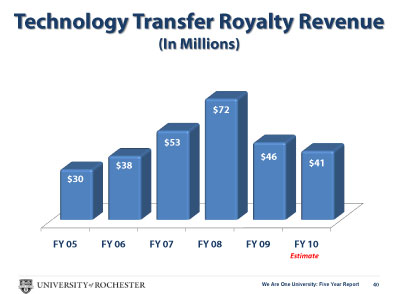
For the past eight years, the University has ranked among the top 10 programs nationally in patent licensing. Our goal is to maintain this level of success in patent licensing, while strengthening our role in startup companies, when this is consistent with our academic mission, which emphasizes the dissemination of knowledge to our society.
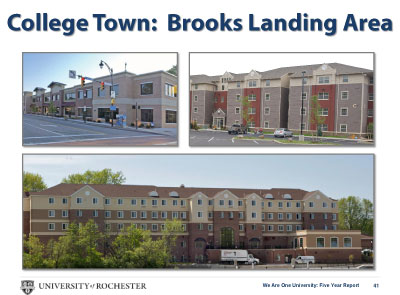
Second, we have sought to develop adjacent areas into college towns. To date, Ron Paprocki and the Facilities senior leadership as well as our Board leadership have achieved considerable success with Brooks Landing, which so far has developed the Staybridge Hotel, a new office building with the University occupying some 20,000 square feet of space, and the nearby Riverview Apartments.
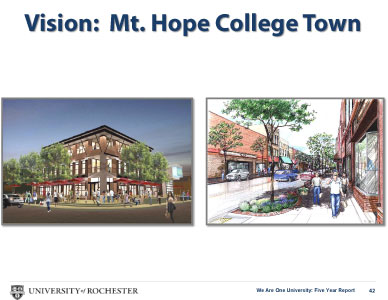
We have begun to develop a second College Town in the Mt. Hope Corridor. We anticipate completing a review of initial responses to our Requests for Proposals within the next few months.
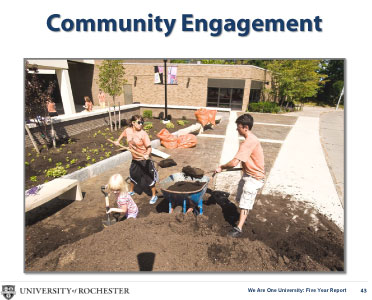
Third, we have amplified the University’s engagement with Rochester. When I arrived, University leaders estimated that there were over 200 College, Medical Center, Simon, Warner, and Eastman community projects in Rochester. Community engagement by our faculty, students, and staff has grown since then.
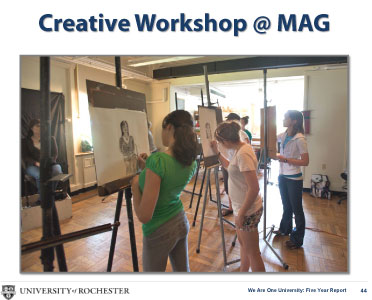
The University’s Memorial Art Gallery, for example, has emphasized such community outreach projects as “Meet Me at the MAG,” a Gallery initiative in conjunction with the Alzheimer’s Association, its Creative Workshop Scholarship program run in conjunction with the Rochester City School District, and ArtWalk, a joint MAG-City project.
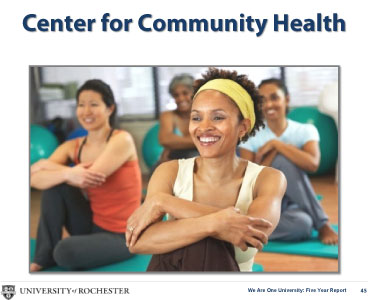
Last year the School of Medicine and Dentistry opened a new 14,000 square foot Center for Community Health on Prince Street. The Center includes the Cancer Services Program, the Emerging Infections Program, and the Healthy Living Center, which addresses, among other things, diabetes and tobacco dependence.
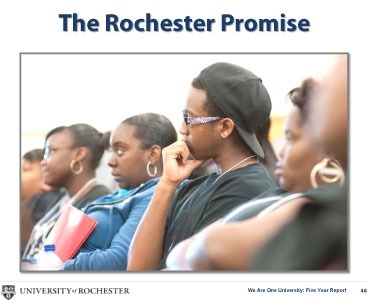
In 2007, the College announced the Rochester Promise, a new scholarship program under which initially up to 40 Rochester City School District students who qualify for admission are awarded $25,000 a year to cover the cost of tuition for four years at the University. To date, the program has had a successful launch with 30 students participating in the program’s first four years.
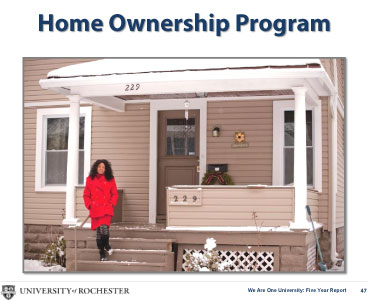
Since 2008, the University, working with the City of Rochester and now three financial institutions, provides $9,000 to each University employee who purchased a home in neighborhoods immediately contiguous to the University. Through August 2010, 115 employees have participated in this program.
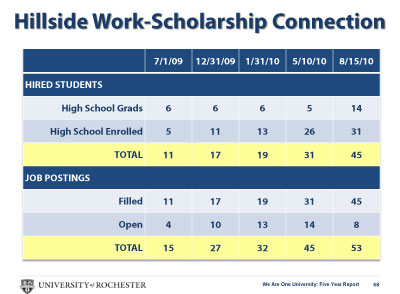
More recently, the University expanded its role in the Hillside Work-Scholarship Connection, which helps at-risk youth stay in high school, achieve academic success, and graduate from high school. As of August 2010, 45 students were working in the Medical Center facilities and the River Campus through the Hillside Work-Scholarship program.
Fourth, we have worked with our state and federal legislative contingents on projects that strengthen the greater Rochester community and the University.
The University took a leadership role in supporting the 2007 enactment of the Empire State Stem Cell Fund, which was intended to provide $600 million over 11 years to support stem cell research, including $16.3 million which has been awarded to the University of Rochester.SLIDE
In addition, we received $8 million in state and federal support for Goergen Hall for Biomedical Engineering and Optics;
$13 million in support for the Eastman Theatre project;
$6.75 million in federal funding for the James P. Wilmot Cancer Center; and
$50 million for the Clinical and Translational Science Building.
Although state and federal budgets are likely to be constrained during the next five years, we will continue to focus on three key projects with appropriate state, federal, city or county representatives:
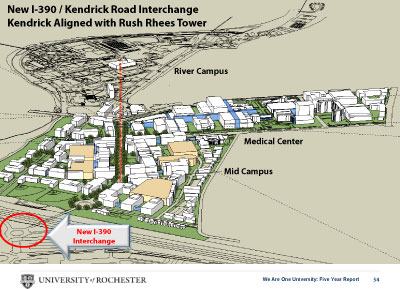
The I-390 Interchange Project, which will create a road network that will facilitate River Campus and Medical Campus growth over the next 20 years;
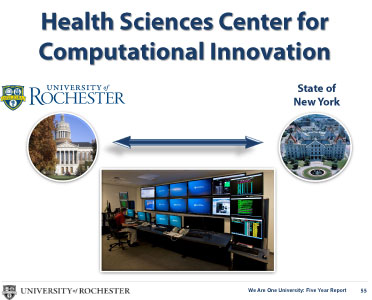
An alliance with New York State and industrial partners to support a path breaking Health Sciences Center for Computational Innovation; and
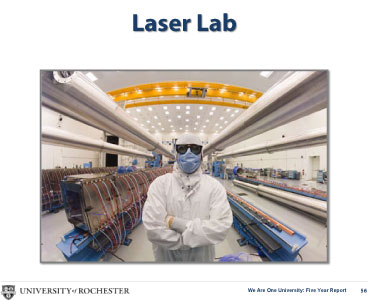
Continuing federal Department of Energy support for the Laser Lab, which has the potential to contribute to the development of fusion energy as a source of clean, carbon-free energy that could be game-changing.
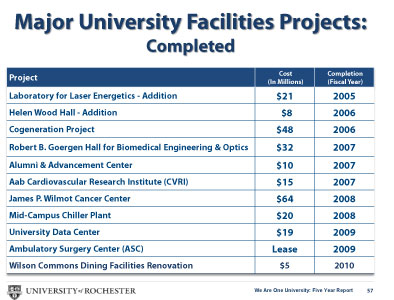
The fifth prong of our efforts to strengthen the Rochester community involves working with the Board Committee on Facilities to develop a Campus Master Plan to guide future University expansion. Consistent with this Master Plan, the University has completed 11 major facilities projects starting in FY 05 with a value of approximately $250 million and
has in progress or planned several further major facilities projects with a value of over $375 million.
The next two years will be memorable for the opening of several new facilities.
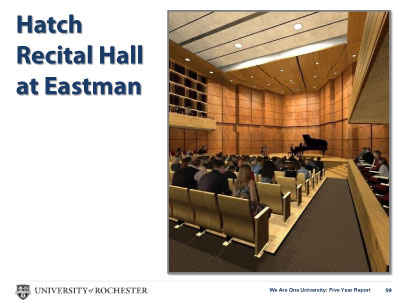
In December, we will dedicate the new wing of Eastman Theatre, with its stunning new Hatch Recital Hall, new faculty offices, large-ensemble rehearsal space and a new atrium featuring an iconic chandelier created by acclaimed glass artist Dale Chihuly.
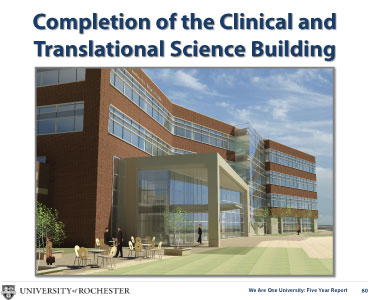
Next spring we will dedicate the Clinical and Translational Science Building.
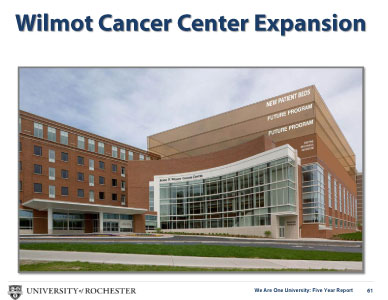
In 2012, we will open three new floors of the James P. Wilmot Cancer Center, adding 45 much-needed beds, taking the first step in the Strong Memorial Hospital modernization and expansion program.
We also have worked to create several new programs to celebrate our University community.
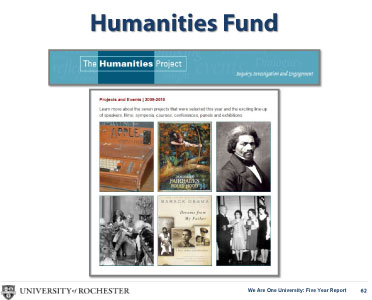
In 2006, I designated Presidential Strategic Opportunities funds for a Humanities Fund to support faculty projects in the arts, languages, and other humanities disciplines. Through the current year, this Fund has awarded $425,000 to 33 projects, including support for Open Letter Press, film preservation and a colloquium in honor of leading historian Hayden White, a former professor at the University of Rochester who revolutionized the field of historiography.
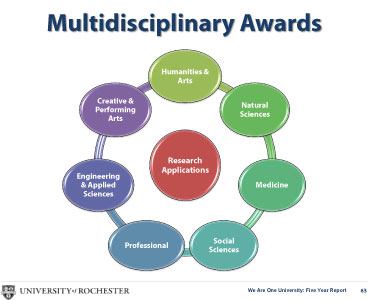
In 2008, the Provost’s Multidisciplinary Awards program was initiated with $250,000 in annual award funding. Provost Ralph Kuncl, assisted by a peer review process, has made 17 interdisciplinary awards in 25 departments to 46 faculty members across our University.
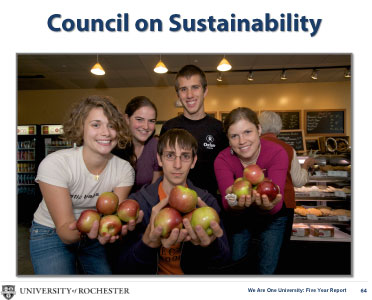
In 2008, the University Council on Sustainability was created for a five-year, renewable period and is co-chaired by Ralph Kuncl and Senior Vice President for Administration and Finance Ron Paprocki. The Council’s work has, among other things, included a significant expansion of the recycling program; a dramatic increase in the use of locally produced food in our dining program; and a meaningful reduction in energy consumption.
D. DIVERSITY
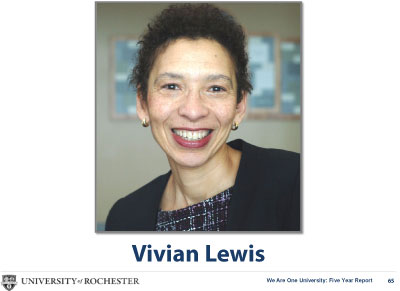
Diversity is a priority for the University of Rochester. Since earlier this year, our Deputy to the President and Vice Provost for Diversity and Development has been Dr. Vivian Lewis.
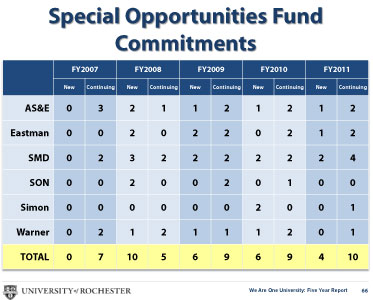
Building on the recommendations of the 2006 Task Force on Diversity and Inclusiveness, several initiatives are now in effect. We have tripled the Special Opportunities Fund to $600,000 between 2005 and this academic year, with a scheduled increase to $750,000 next academic year. This Fund has aided in the hiring of 21 and retention of six underrepresented faculty between 2006 and 2010. Each school has designated a Faculty Diversity Officer with a University Faculty Diversity Officers Committee coordinating diversity and inclusiveness initiatives. We are attempting to better address building applicant pools and creating a more welcoming and inclusive community.
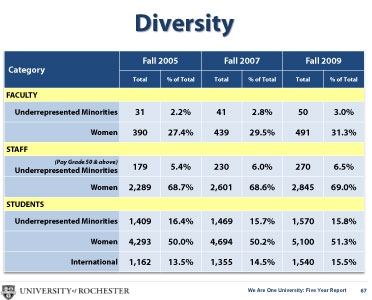
There has been some progress to date. The number of underrepresented faculty in the medical school and nonmedical faculty throughout the University increased between FY 06 and FY 09 from 37 to 50 (2.6 to 3 percent), but had been higher in FY 08. The number of female professors grew from 441 to 491 (28.6 percent to 31.2 percent).
Separately, there is a Board-led initiative to address staff diversity that predated my arrival as well as school admissions programs. For staff pay grade 50 and above, there has been some growth in underrepresented minority employment at the University (from 179 or 5.4 percent in FY 05 to 270 or 6.5 percent in FY 09). Our student diversity programs were well established before I arrived and have continued to report that approximately 16 percent of our students throughout the University were from underrepresented minorities and approximately 50 percent were women both in FY 05 and FY 09.
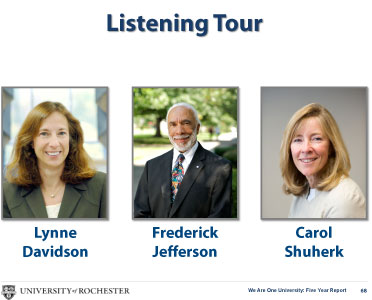
In 2009, Lynne Davidson, Professor Emeritus Frederick Jefferson, and Senior Associate Provost Carol Shuherk completed a year-long listening tour of nonminority and minority faculty and issued a report titled Improving Faculty Recruitment and Retention at the University of Rochester: A Diversity and Inclusion Initiative. This initiative went beyond data to attempt to understand our culture. I am committed to attempting to implement its 14 recommendations, which address faculty development, leadership support, and organizational culture.
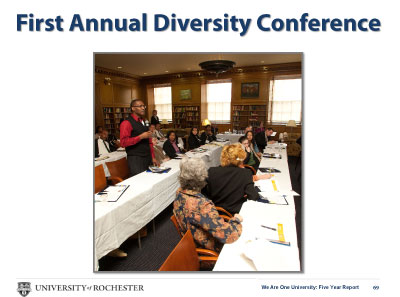
In April 2010, the University hosted our first University-wide conference to address what the schools and faculty, student, and staff programs can learn from each other. We were delighted that several Trustees or Life Trustees participated, including Jerry Gardner, Francis Price, Cathy Minehan, Tom Richards, Carl Williams, and Bob Witmer.
E. STRATEGIC PLANNING
The key to building on our collective strengths and addressing our common challenges is strategic planning.
After a multi-year effort, the University and each academic division worked with the University Board Strategic Planning Advisory Committee, chaired by Trustee Robert Goergen, in developing strategic plans, which were approved by the Board of Trustees in October 2008.
Our objectives were clear. By the conclusion of the Comprehensive Campaign in June 2016, we envisioned:
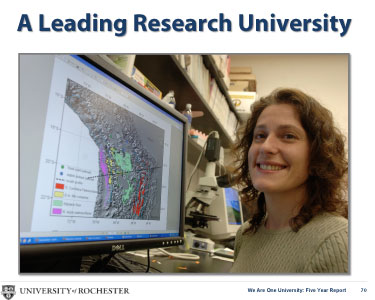
-
- A University whose quality places it among the leading 20 leading research universities in the United States based upon an unrelenting commitment to our fundamental values.
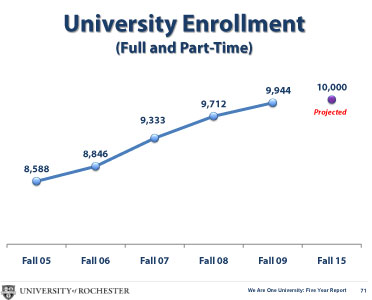
A student body that has grown from approximately 8,300 total students in Fall 2004 to approximately 10,000 students by Fall 2015, while strengthening quality and diversity. Underlying this progress will be a decisive growth in scholarship support.
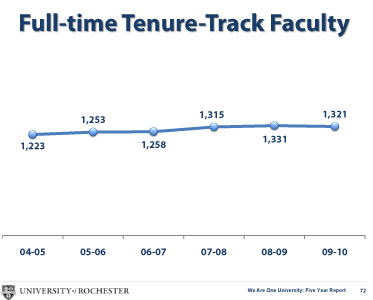
A concomitant growth in our tenured and tenure track faculty, made possible in part by a substantial increase in endowed professorships, building on the 23 endowed professorships created since 2005.
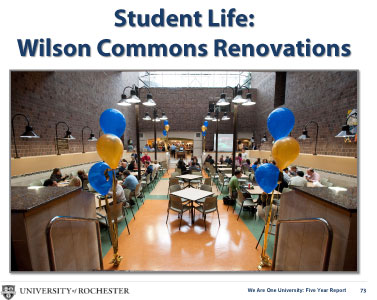
Dramatic improvements in student residential life with new dining and residential facilities,
expanded athletic facilities and a substantial start on expanded College performing arts programs and facilities.
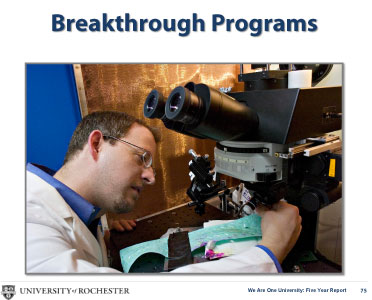
Breakthrough programs such as Neuromedicine at the Medical Center; Technical Entrepreneurship and Management (TEAM) that links the College and Simon; and the Eastman School’s proposed Music and Media Center, which will combine music, digital media, dance and drama.
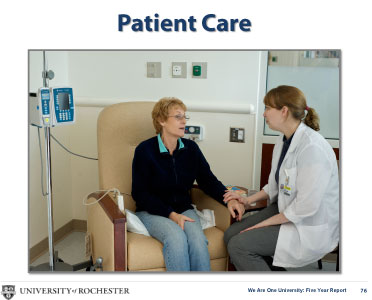
Greater ability to provide the highest quality patient care by completing the expansion of the Wilmot Cancer Center, building our first 21st century tower to revitalize Strong Memorial Hospital, and creating a fully integrated Electronic Medical Records system.
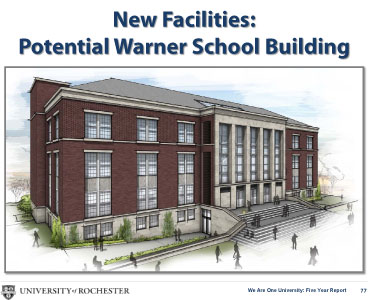
Approximately $1 billion or more of new facilities in total between July 2005 and June 2016, including such projects as completing the renovation of the Eastman Theatre and the Clinical and Translational Science Building, building the new Warner School building and a new College sciences and engineering facility, expanding the College Town at Brooks Landing, and completing a new College Town in the Mt. Hope corridor.
- A sustainable significantly higher level of annual giving to provide enduring resources to support the vitality of University programs.
- A University-wide budget at or near our target 5.5 percent annual endowment draw rate.
The most serious economic recession of the post-World War II period caused us to modify our strategic plans, but our objectives remain largely intact with the enduring potential for our campaign to be transformative for our University.

Our fundamental objective remains to build on our momentum and become one of the 20 leading research universities in the United States. We recognize that we cannot control the stock market and will not be able to control the absolute size of our endowment on June 30, 2016. But we will focus both on achieving the greatest feasible success in our first comprehensive capital campaign and creating a sustainable higher level of annual support.
A global objective for all schools is scholarships for our students and greater support for our faculty through such means as endowed professorships. We are an institution whose magnitude of success can be measured by the support we provide for our faculty and students.
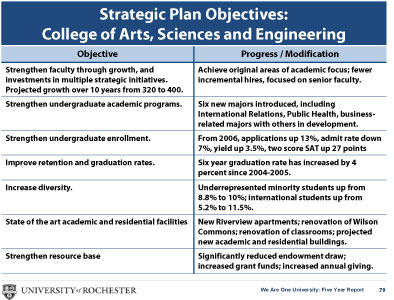
For the College, quality growth is a key theme, with a goal of increasing the faculty to at least 350. This will support an array of new programs in fields such as international relations and biomedical optics; programs that bridge the arts and humanities with science and engineering, including initiatives in digital humanities and new media; and significant initiatives in systems science and engineering to enable the College to be a national leader in pivotal fields of multidisciplinary research. The College aspires to construct a new flagship science and engineering building as well as to expand and renovate classrooms and labs, Fauver Stadium and its performing arts facilities.
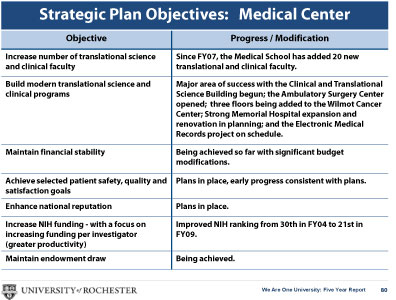
For the Medical Center, the pivotal aspirations balance the Medical Center’s powerful momentum in research and clinical care with a challenging health care financial environment. Innovation through research will be emphasized, especially in the Center’s five core Integrated Disease Programs – Neuromedicine, Cardiovascular, Cancer, Musculoskeletal and Immunobiology and Infection. The Medical Center anticipates further progress with the opening of the Clinical and Translational Science Building. In the next years, the Medical Center also will achieve greater ability to provide the highest quality patient care by completing the installation of a fully integrated Electronic Medical Record system across the Medical Center, modernizing and replacing patient care facilities at Strong Memorial Hospital, Highland Hospital and its long-term care facilities.
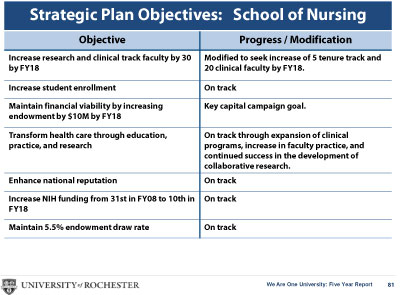
In the first decades of the 21st century, few professions will experience greater growth in size and importance than nursing. Our School of Nursing is well positioned to be a thought leader in the profession’s evolution. For Nursing, goals include strengthening collaborative relationships with the School of Medicine and Dentistry and the River Campus.
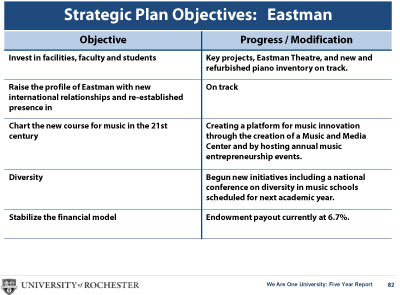
For the Eastman School of Music, the nation’s “Hottest Music School,” according to Kaplan/Newsweek (2008), a paramount objective will be to lead music education in the 21st century through such means as a new Center for Music Innovation and Engagement and the Eastman Music and Media Center. Eastman has been a leader in connections to the Rochester community, with its Eastman Community Music School currently serving roughly 1,300 students a year and the Eastman School presenting more than 700 public concerts a year. In the first decades of the 21st century, Eastman intends to develop a new facility to house the Eastman Music and Media Center and focus on strengthening such programs as Eastman in New York City.
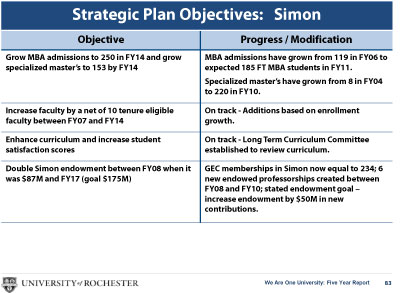
The Simon School of Business has long been among the nation’s most intellectually innovative in business education. Last year the Financial Times ranked Simon 5th in the world in finance; 4th in accounting; 5th in managerial economics; and 8th in statistics. Simon’s future will include multidisciplinary programs coordinate with the College, such as the TEAM master’s program and joint endowed professorships; entrepreneurship initiatives such as the Mark Ain Business Model Workshops and Competition; Leadership Development, among other things, through a tutor-based Management Communication Program; and outreach with a new master’s program in Finance scheduled to begin in New York City in 2011.

No academic division has grown faster in recent years than the Warner School of Education. What most distinguishes Warner faculty and students in their research is a shared concern for contributing to excellence and equity, particularly in K-12 education. Warner’s future will include new programs that bridge education with other fields such as business and health care as well as an increased partnership with the Rochester City School District and other local agencies committed to improving education in the region. Warner’s most significant immediate objective is a new facility to house its faculty, students and community programs.
III THE CAMPAIGN FOR ROCHESTER
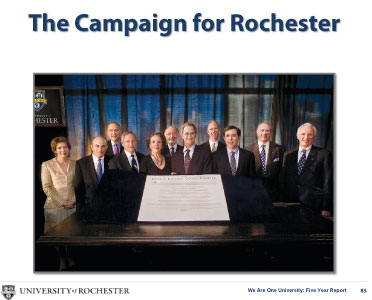
I started my first communication to the University community on July 1, 2005, with the words: “The campaign for the University of Rochester began today.” We embarked on planning what will be the most significant comprehensive capital campaign in our history. This is our chance to galvanize the resources that will allow us to achieve the aspirations of our strategic plans and to build on the great strengths of our University to be ever better in our teaching, research, clinical care, creative and performing arts and community leadership.
To successfully conduct our first modern comprehensive capital campaign, we will act as One University, united in articulating a compelling vision for a great research university in the first decades of the 21st century. All of us – our faculty, our administrators, our students, our staff, our trustees, our alumni and our friends – are partners in a campaign to align the mission of our University with the enthusiasm and support of our alumni and friends.
For some time, we have been quietly preparing for this comprehensive campaign.
Advancement has been engaged in conducting research, including surveys, interviews, polling and focus groups, to better understand the beliefs of the alumni and friends devoted to our University. The results show a strong commitment to the spirit and idea of Meliora.
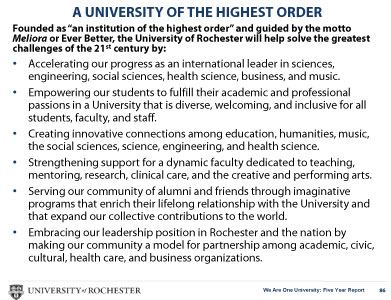
Meliora, ever better, was the basis for the Campaign Vision Statement that was adopted last year. This Statement articulates our vision of seeking to help solve the great challenges of the 21st century by building on our academic strength; empowering our students in a University that is diverse, welcoming and inclusive for all students, faculty and staff; creating innovative connections among our schools; strengthening support for our dynamic faculty; serving our community of alumni and friends; and embracing our leadership position in Rochester and the nation in partnership with academic, civic, cultural, health care and business organizations.
More recently, I have engaged the deans and other University leaders in efforts to articulate a unified series of resonant and persuasive campaign objectives and themes, in some instances focusing at the school or Medical Center levels.
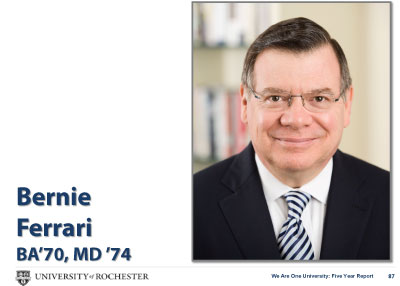
We will further test the specific campaign objectives and themes with leading friends and donors throughout this academic year. We are receiving great advice for this effort from a Campaign Marketing Workgroup, formed by the Board of Trustees Development Committee, and chaired by Trustee Bernie Ferrari, BA ’70, MD ’74.
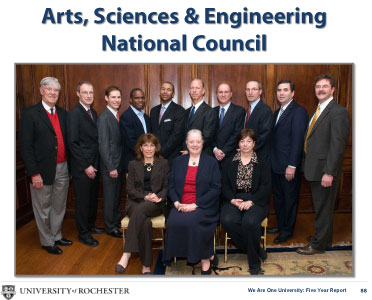
In spring 2011, the Board of Trustees, National Councils and Regional Cabinets will hold a Campaign Leadership Retreat. Based in part on discussions at the Retreat, I will subsequently ask the Board at its May 2011 meeting to authorize the public launch of our comprehensive campaign in October 2011.
Each of these steps in the process of developing the most compelling case for philanthropic investment further focuses our identity and will help all of us to be the most effective advocates for our University during the campaign.
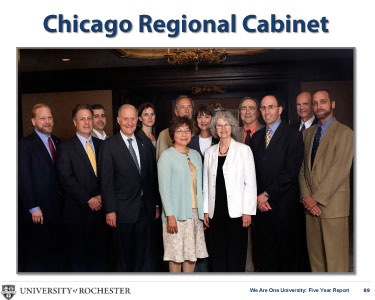
Simultaneously, Advancement has been engaged in a highly successful effort to identify our supporters. We are listening to them. Their loyalty and commitment to the University are pivotal to the success we will achieve in our campaign. To date, we have established eight National Councils and four Regional Cabinets, with more Cabinets to be created. We have visited over 5,000 new prospective major donors so far.
Today, I particularly want to encourage the faculty to become involved. A comprehensive campaign is about more than raising money. It is fundamentally a conversation about ideas and our future. No group can better articulate the ideas that will be the basis of our campaign than the faculty. Our alumni and supporters are eager to hear from you and to meet with you. We hope that you will embrace the opportunity to share your excitement about your work and your sense of our future with our alumni and friends. You can be among our most powerful ambassadors.
In many instances, you can provide tremendous service to our University by speaking to groups of alumni, parents, and friends about your teaching and research and your enthusiasm for the University of Rochester.
I want to particularly thank each of you who have also financially contributed to the University. By joining the George Eastman Circle or supporting specific University projects, you are publicly and visibly demonstrating your commitment to the value of your University. For our alumni and friends, there can be no more powerful vote of confidence than your support of our campaign.
IV CONCLUSION
In the past I have communicated my commitment to our University by committing 10 percent of my base salary to the University. A capital campaign is a time to stretch. Friederike and I now want to make a commitment of $1 million to the campaign counting our past and future annual giving. We are inspired to make this commitment by heroes of ours – academics like Bob Sproull and Mark Zupan who have made extraordinary gifts and commitments to the University and friends and trustees who have been leaders in building our University like George Eastman, Joe Wilson, Bob Goergen, Ed Hajim and Tom Golisano, as well as many other trustees, alumni and friends of our University who have often been incredibly generous in their support of the University of Rochester.
I owe virtually everything that I have achieved in my life to education. Without college education at the University of California and legal education at Harvard, I would not be here today. I would not have begun an academic career 33 years ago. I would not have had the opportunities to teach and do research at some of the leading universities in the land.
I believe in the paramount significance of the research university as the decisive social institution of our time. We have the laboratories where diseases are cured and new sources of energy will be discovered; we have the classrooms and professors’ offices where new paradigms for the social sciences, the humanities and our professional schools are developed; we are the teachers of the next generation of leaders throughout the world; we are the hospitals and health care providers who tend to the welfare and quality of life of vast regions; we are the center of a culture that has dazzled the world with its humanities, its performing arts, its commitment to democratic values.
Most of all, I believe in the University of Rochester. We are an institution that has consistently generated transforming ideas that have made an extraordinary impact in every field that we have touched. We are innovative. We will be here perpetually. We will provide the new discoveries, the leaders, the culture that will help move and inspire people throughout our city, our region, our nation and our world.
I am proud to be a member of the faculty of the University of Rochester and to be part of the campaign to make our University ever better.
Meliora.
